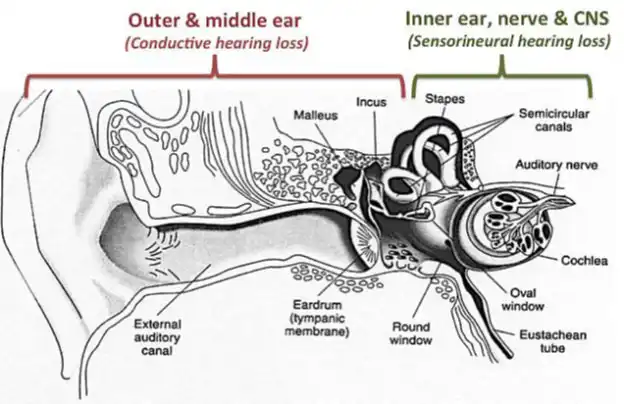Hearing loss

Hearing loss can be divided into two types: Conductive Hearing Loss, which is essentially a mechanical problem with the conduction of sound vibrations, and Sensorineural Hearing Loss, a problem with the generation and/or transmission of nerve impulses from the inner ear to the brain. Mixed hearing loss refers to a combination of these two types. The preliminary classification of hearing loss as conductive or sensorineural can be determined by a physician using a tuning fork in the office. A formal audiogram, or hearing test, is the best way to determine the type and degree of hearing loss. The distinction between these two types of hearing loss is important because many cases of conductive hearing loss can be improved with medical or surgical intervention. An otolaryngologist, also called an Ear Nose and Throat or ENT doctor, can determine the specific diagnosis and treatments for either type of hearing loss and perform surgical treatments, if necessary.
-
Conductive hearing loss – when hearing loss is due to problems with the ear canal, ear drum, or middle ear and its little bones (the malleus, incus, and stapes).
-
Sensorineural hearing loss (SNHL)– when hearing loss is due to problems of the inner ear, also known as nerve-related hearing loss.
-
Mixed hearing loss– refers to a combination of conductive and sensorineural hearing loss. This means that there may be damage in the outer or middle ear and in the inner ear (cochlea) or auditory nerve.
Conductive Hearing Loss
Causes
-
Malformation of outer ear, ear canal, or middle ear structures
-
Fluid in the middle ear from colds
-
Ear infection(otitis media – an infection of the middle ear in which an accumulation of fluid may interfere with the movement of the eardrum and ossicles
-
Allergies
-
Poor Eustachian tube function
-
Perforated eardrum
-
Benign tumors
-
Impacted earwax
-
Infection in the ear canal
-
Foreign body in the ear
-
Otosclerosis
Sensorineural Hearing Loss
Causes
-
Exposure to loud noise
-
Head trauma
-
Virus or disease
-
Autoimmune inner ear disease
-
Hearing loss that runs in the family
-
Aging (presbycusis)
-
Malformation of the inner ear
-
Meniere’s Disease
-
Otosclerosis – a hereditary disorder in which a bony growth forms around a small bone in the middle ear, preventing it from vibrating when stimulated by sound.
-
Tumors
Degree of Hearing Loss:
| Pure tone average (dB HL) |
Degree of Hearing Loss |
| < 15 |
Normal |
| 16 – 25 |
Slight |
| 26 – 40 |
Mild |
| 41 – 55 |
Moderate |
| 56 – 70 |
Moderately severe |
| 71 – 90 |
Severe |
| ≥ 90 |
Mild |
